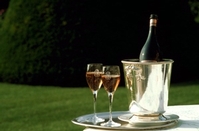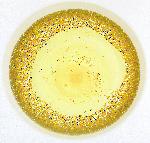Let us speak frankly: The world is full of sparkling wines, but there’s an important sense in which selecting any of them from anywhere in the world other than France’s Champagne  region is a trade-down.
region is a trade-down.
That frank truth conveys something virtually unique about sparkling wine. As a point of comparison, buying Cabernet from places other than Bordeaux is not regarded as a trade-down by hordes of wine lovers who prefer the somewhat more opulent style that the grape attains in places like the Napa Valley or Coonawarra or Chile’s Maipo Valley. The same is true for Pinot Noir. Plenty of people think red Burgundy is too inconsistent in quality and angular in style to really deserve the veneration with which it is generally regarded. Given a set sum of money to spend, they’d really rather have a bottle from a place like Oregon.
But everything is different when bubbles are involved. The degree to which Champagne stands apart is indicated clearly by the nomenclature that we use when addressing this whole  wine category: There’s “Champagne,” on one hand, and then there’s everything else, which gets lumped together as “Sparkling Wine.”
wine category: There’s “Champagne,” on one hand, and then there’s everything else, which gets lumped together as “Sparkling Wine.”
Of course there are people–and wine companies–that fail to respect this distinction, using the term “Champagne” for sparkling wines sourced from elsewhere. Yet, even this proves the point, as any such usage of the “C word” is enough to start a fight with the French. Tellingly, the CIVC (the association representing the Champagne industry) now spends almost all of its time and money in the United States fighting for a certain usage of the word rather than promoting consumption of the product.
We can regard the point as established, but–like all points–it has its limits. Although it may be true that nothing sparkles like Champagne, some extraordinary sparklers still look like good buys even if they are not priced dramatically lower than Champagne. For example, Roederer Estate from Mendocino is good enough to look pretty attractive at $20 even if you could find true Champagne discounted to $30.
Nevertheless, any shrinkage of that price differential would be bad news for the Roederer, and it is an inherently perilous business model to try to sell any sparkling wine that is similar in  style to Champagne unless is it very different in price.
style to Champagne unless is it very different in price.
A more viable strategy is to sell sparklers that are different in price and style, and this is precisely why Prosecco has taken off in the USA while Franciacorta has always been a commercial dud–despite being a delicious product. Even relatively pricy Prosecco can be very attractive, as in the case of Prosecco di Valdobbiadene “Primo” from Nino Franco. Priced at $28, it is a threat to Champagne because it is stylistically distinct in its fresh, foamy, faintly floral and directly fruity profile. A distinctive, completely convincing wine, it doesn’t make one wonder whether it would have been better to spend $10 more to get Champagne–because it really doesn’t tasted like Champagne.
The same can be said of Château de L’Aulée’s Crémant de Loire Brut NV, which I’ve reviewed this week on WRO and scored at 91 points. It is beautifully balanced and quite complex like any good Champagne, yet creamier, fruitier, and very slightly floral in a way that makes is quite distinctive. I’ve tried this Chenin Blanc-based sparkler several times in recent months, and regarded it extremely highly in each instance–even though it doesn’t bring Champagne to mind. Or perhaps because of that?
1
